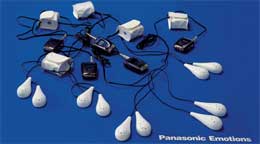The Panasonic Emotions Testing Line, by “nomadic” development designer Jiří Černický, is a conceptual SD audio-prosthesis that aims to grasp the issue of the emotional deficits in society.

The device is a substitute, personal container for the emotions of users who are not able, or do not want, to experience life through their own emotional perceptions. It looks like a Walkman-type device with headphones that does not play music inside, but rather outside, of the head. The device facilitates the user’s emotional communication with the world around him. It is not designed for his/her personal use only but is equipped with a tiny amplifier.
The memory of the SD Audio Player chip card contains a great amount of data containing recordings of authentic human emotions. For instance, if the user finds himself in a situation where he has to argue with someone, yet he does not want to get into confrontation and to waste his own emotions, he locates a password on his SD Audio Player representing an appropriate emotional response, which he then applies accordingly.

The SD Audio Player can also record and thus appropriate other people’s emotions: sniveling, peevishness, sobbing, moaning, crying, gradual emotional collapse, breakdown, yelling by a beaten person, the state of mind between laughter and crying, the hysterical family argument from Fellini’s film Amarcord, pubescent giggling, comforting and fondling of a baby, a feeling of well-being, enthusiastic effusions, wearing somebody out, cuddling, soothing, etc. Such recordings, including those from movies, can be further edited and modified on a computer. In this way, the user can appropriate the emotions that are conveyed by celebrities and other prominent individuals.
Via Vvork.
See also Ku: iyashikei-net by Urico Fujii and Ann Poochareon is a networked crying sculpture that allows people to communicate through the interface of tears.







